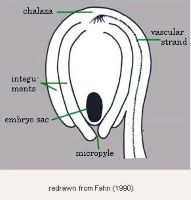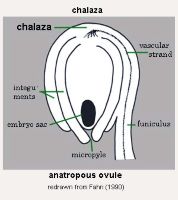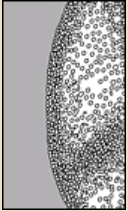Content is from Kirkbride et al. 2006Kirkbride et al. 2006:
Kirkbride JH, Jr, Gunn CR, and Dallwitz MJ. 2006. Family guide for fruits and seeds, vers. 1.0. Accessed September 2020-January 2022. URL: https://nt.ars-grin.gov/seedsfruits/keys/frsdfam/index.cfm ., without modification.
Updates are forthcoming.
 and mesocarpmesocarp:
and mesocarpmesocarp: absent and endocarpendocarp:
absent and endocarpendocarp: exposed, or seed.
exposed, or seed.
Fruits: Pistil(s) 1; 1-pistillate. Fruit pericarpium; simple; nuculanium (Harungana madagascariensis), or drupedrupe:
(indehiscent drupe) a fleshy, indehiscent fruit with one more hard pits enclosing seeds, derived from single, superior, simple or compound ovary; (dehiscent drupe) a fruit with a dry or fibrous to fleshy or leathery outer husk that early to tardily breaks apart (or opens), exposing one or more nutlike pits enclosing the seeds (Endodesmia), or capsulecapsule:
(Endodesmia), or capsulecapsule:
a dry, dehiscent fruit derived from a compound ovary , or berryberry:
, or berryberry:
an indehiscent, fleshy fruit with one or a few to many seeds. The flesh may be homogenous throughout. Or, if the outer part is hard, firm, or leathery, referred to as an hesperidium. Septa are present in some, and the seeds may be arillate or with a fleshy testa. ; septifragalseptifragal:
; septifragalseptifragal:
type of capsular dehiscence, splitting through the exterior wall suture(s) but not the septum(-a), the valves of the wall then separating from the septum(-a) and the locules thus opened directly to the outside
capsulecapsule:
a dry, dehiscent fruit derived from a compound ovary , or septicidalsepticidal:
, or septicidalsepticidal:
type of capsular dehiscence, opening longitudinally by separating between the septa of adjacent carpels
 capsulecapsule:
capsulecapsule:
a dry, dehiscent fruit derived from a compound ovary (Tovomita); capsulecapsule:
(Tovomita); capsulecapsule:
a dry, dehiscent fruit derived from a compound ovary not inflated; capsulecapsule:
not inflated; capsulecapsule:
a dry, dehiscent fruit derived from a compound ovary without operculumoperculum:
without operculumoperculum:
a dehiscent cap (or lid) of a seed or fruit that opens during germination or dehiscence ; berryberry:
; berryberry:
an indehiscent, fleshy fruit with one or a few to many seeds. The flesh may be homogenous throughout. Or, if the outer part is hard, firm, or leathery, referred to as an hesperidium. Septa are present in some, and the seeds may be arillate or with a fleshy testa. indehiscent; berryberry:
indehiscent; berryberry:
an indehiscent, fleshy fruit with one or a few to many seeds. The flesh may be homogenous throughout. Or, if the outer part is hard, firm, or leathery, referred to as an hesperidium. Septa are present in some, and the seeds may be arillate or with a fleshy testa. without central placental mass; with persistent central column, or without persistent central column; valves not diverging at top of central column; not within accessory organ(s); from 1–5 cm long; 4 cm long; with (1–)3–5(–20)-carpellate (+); with carpels united; with carpels remaining united at maturity; without sterilesterile:
without central placental mass; with persistent central column, or without persistent central column; valves not diverging at top of central column; not within accessory organ(s); from 1–5 cm long; 4 cm long; with (1–)3–5(–20)-carpellate (+); with carpels united; with carpels remaining united at maturity; without sterilesterile:
lacking male and/or female reproductive parts; also, not producing fruit or seed
 carpels; apexapex:
carpels; apexapex:
the point farthest from the point of attachment, or the "tip" of an organ not beaked; wall fleshy and leatheryleathery:
not beaked; wall fleshy and leatheryleathery:
texture—moderately thick, tough, and very pliable
; dehiscentdehiscent:
(v. dehisce) splitting open at maturity to release contents (of a fruit) , or indehiscentindehiscent:
, or indehiscentindehiscent:
not opening on its own, as in a fruit
 . Dehiscentdehiscent:
. Dehiscentdehiscent:
(v. dehisce) splitting open at maturity to release contents (of a fruit) unit seed(s). Dehiscentdehiscent:
unit seed(s). Dehiscentdehiscent:
(v. dehisce) splitting open at maturity to release contents (of a fruit) regularly; and shedding seeds; without replumreplum:
regularly; and shedding seeds; without replumreplum:
the rim, formed by the persistent placentas, and connected by a false septum in Brassicaceae fruits. The fruit valves are attached to this rim and separate from it in dehiscent fruits.
. Epicarpepicarp:
outer layer of fruit wall or pericarp, if divided into layers; note here used synonymously with exocarp durable; without armature; without wing(s); without apicalapical:
durable; without armature; without wing(s); without apicalapical:
at or pertaining to the end of the seed or fruit distal from its point of attachment (i.e., base)
respiratory hole. Mesocarpmesocarp:
the middle layer of the pericarp, if divided into layers present; fleshy; composed of 1 unified layer; without lactiform cavity system. Endocarpendocarp:
present; fleshy; composed of 1 unified layer; without lactiform cavity system. Endocarpendocarp:
the inner layer of the pericarp, if divided into layers present, or absent; not separating from exocarpexocarp:
present, or absent; not separating from exocarpexocarp:
outer layer of fruit wall or pericarp, if divided into layers; note here used synonymously with epicarp ; thin, or hard; not splitting into 1-seeded pyrenes; smooth; without wing; without operculumoperculum:
; thin, or hard; not splitting into 1-seeded pyrenes; smooth; without wing; without operculumoperculum:
a dehiscent cap (or lid) of a seed or fruit that opens during germination or dehiscence ; without secretory cavities; without mechanism for seedling escape; without grooves; without longitudinallongitudinal:
; without secretory cavities; without mechanism for seedling escape; without grooves; without longitudinallongitudinal:
of or relating to length or the lengthwise dimension
ridges. Funiculusfuniculus:
(alt. funicle) stalk connecting the ovule (later seed) to the ovary (later fruit) placenta short; short without seed bearing hookswith hooks:
short; short without seed bearing hookswith hooks:
bristles or spines with curved or backwards pointing tips, or with secondary bristles along their length (retinacula); not persisting in fruit after seed shed.
(retinacula); not persisting in fruit after seed shed.
 present (Clusieae), or absent (Hypercoideae, Kielmeyerioideae, Moronbeiodeae, Garcinieae); a true arilaril:
present (Clusieae), or absent (Hypercoideae, Kielmeyerioideae, Moronbeiodeae, Garcinieae); a true arilaril: , or an arillike structure; orange, or red, or yellow; adnate to hilumhilum:
, or an arillike structure; orange, or red, or yellow; adnate to hilumhilum: (Clusioideae); of funicularfuniculus:
(Clusioideae); of funicularfuniculus: origin, or micropylarmicropyle:
origin, or micropylarmicropyle: origin; lobed, or unlobed. Arillike structure falling with seed a chalazachalaza:
origin; lobed, or unlobed. Arillike structure falling with seed a chalazachalaza: ; dilated into membranousmembranous:
; dilated into membranousmembranous: ; without caudatecaudate:
; without caudatecaudate: appendage(s); at maturity with food reserves, or without apparent food reserves; with endosperm; without canavanine. Sarcotestasarcotesta:
appendage(s); at maturity with food reserves, or without apparent food reserves; with endosperm; without canavanine. Sarcotestasarcotesta: absent. Testatesta:
absent. Testatesta: present; without fleshy or leatheryleathery:
present; without fleshy or leatheryleathery: ; surface reticulatereticulate:
; surface reticulatereticulate: ; without crease or line separating cotyledons from hypocotyl-radicle; without notch along margin where cotyledons from hypocotyl-radicle tip approach each other; without glands; without bristles; without wings, or with wing(s) (Hypericoideae); 1-winged; with wing at one end, or wing encompassing seed; without collar; without operculumoperculum:
; without crease or line separating cotyledons from hypocotyl-radicle; without notch along margin where cotyledons from hypocotyl-radicle tip approach each other; without glands; without bristles; without wings, or with wing(s) (Hypericoideae); 1-winged; with wing at one end, or wing encompassing seed; without collar; without operculumoperculum: ; colored; monochrome; brown (all shades); crustaceouscrustaceous:
; colored; monochrome; brown (all shades); crustaceouscrustaceous: (no food reserve); at one end of seed not extending into a depression or cup; axileaxile:
(no food reserve); at one end of seed not extending into a depression or cup; axileaxile: entire; with margins separate, or connate (Calophylloideae); basally entire; equal in size; not punctatepunctate:
entire; with margins separate, or connate (Calophylloideae); basally entire; equal in size; not punctatepunctate: dotted. Hypocotyl-radicle vestigial, or small, or moderately developed, or well developed; straight (assumed); much thickened, or not thickened.
dotted. Hypocotyl-radicle vestigial, or small, or moderately developed, or well developed; straight (assumed); much thickened, or not thickened.
Noxious weeds: 1 or more USA state noxious weeds in this family.
USA states and territories with listed noxious weeds: California (CA), Colorado (CO), Hawaii (HI), Idaho (ID), Montana (MT), Nevada (NV), Oregon (OR), South Dakota (SD), and Washington (WA).
USA state and territory noxious weeds:
Hypericum perforatum L.: USA state noxious weed: CA●°, CO●°, HI°, ID°, MT●°, NV●°, OR°, SD●, WA●°.
Symbols: ªaquatic weed; ●terrestrial weed; °weed in seed.
Last updated February 2006.
Also see Bonnetiaceae. Subfamilies Kielmeyeroideae - seeds without arilsaril:
(broad sense) appendicular structure that wholly or partly envelops a seed and is produced from or a modification of the funicle, raphe, or outer integument; usually fleshy or pulpy, sometimes spongy or tufted-capillate, often brightly colored , cotyledons separate; and Hypericoideae - fruit capsulecapsule:
, cotyledons separate; and Hypericoideae - fruit capsulecapsule:
a dry, dehiscent fruit derived from a compound ovary or berryberry:
or berryberry:
an indehiscent, fleshy fruit with one or a few to many seeds. The flesh may be homogenous throughout. Or, if the outer part is hard, firm, or leathery, referred to as an hesperidium. Septa are present in some, and the seeds may be arillate or with a fleshy testa. , rarely drupedrupe:
, rarely drupedrupe:
(indehiscent drupe) a fleshy, indehiscent fruit with one more hard pits enclosing seeds, derived from single, superior, simple or compound ovary; (dehiscent drupe) a fruit with a dry or fibrous to fleshy or leathery outer husk that early to tardily breaks apart (or opens), exposing one or more nutlike pits enclosing the seeds , seeds 5-many, without arilsaril:
, seeds 5-many, without arilsaril:
(broad sense) appendicular structure that wholly or partly envelops a seed and is produced from or a modification of the funicle, raphe, or outer integument; usually fleshy or pulpy, sometimes spongy or tufted-capillate, often brightly colored , cotyledons free; Calophylloideae - fruit drupedrupe:
, cotyledons free; Calophylloideae - fruit drupedrupe:
(indehiscent drupe) a fleshy, indehiscent fruit with one more hard pits enclosing seeds, derived from single, superior, simple or compound ovary; (dehiscent drupe) a fruit with a dry or fibrous to fleshy or leathery outer husk that early to tardily breaks apart (or opens), exposing one or more nutlike pits enclosing the seeds or occasionally capsulecapsule:
or occasionally capsulecapsule:
a dry, dehiscent fruit derived from a compound ovary with 1–4 seeds without arilsaril:
with 1–4 seeds without arilsaril:
(broad sense) appendicular structure that wholly or partly envelops a seed and is produced from or a modification of the funicle, raphe, or outer integument; usually fleshy or pulpy, sometimes spongy or tufted-capillate, often brightly colored , embryo large with united cotelydons; Moronbeioideae - fruit berryberry:
, embryo large with united cotelydons; Moronbeioideae - fruit berryberry:
an indehiscent, fleshy fruit with one or a few to many seeds. The flesh may be homogenous throughout. Or, if the outer part is hard, firm, or leathery, referred to as an hesperidium. Septa are present in some, and the seeds may be arillate or with a fleshy testa. with (1)-many seeds without arilsaril:
with (1)-many seeds without arilsaril:
(broad sense) appendicular structure that wholly or partly envelops a seed and is produced from or a modification of the funicle, raphe, or outer integument; usually fleshy or pulpy, sometimes spongy or tufted-capillate, often brightly colored and embryos undifferentiated; Clusioideae - subdivided into Clusieae - fruit usually capsulecapsule:
and embryos undifferentiated; Clusioideae - subdivided into Clusieae - fruit usually capsulecapsule:
a dry, dehiscent fruit derived from a compound ovary with 5-many seeds with arilsaril:
with 5-many seeds with arilsaril:
(broad sense) appendicular structure that wholly or partly envelops a seed and is produced from or a modification of the funicle, raphe, or outer integument; usually fleshy or pulpy, sometimes spongy or tufted-capillate, often brightly colored , embryo with large hypocotylhypocotyl:
, embryo with large hypocotylhypocotyl:
portion of the embryonic axis below the cotyledons and above the radicle
and vestigal to no cotyledons; and Garcinieae - fruit drupedrupe:
(indehiscent drupe) a fleshy, indehiscent fruit with one more hard pits enclosing seeds, derived from single, superior, simple or compound ovary; (dehiscent drupe) a fruit with a dry or fibrous to fleshy or leathery outer husk that early to tardily breaks apart (or opens), exposing one or more nutlike pits enclosing the seeds with 1–5(-13) seeds without arilsaril:
with 1–5(-13) seeds without arilsaril:
(broad sense) appendicular structure that wholly or partly envelops a seed and is produced from or a modification of the funicle, raphe, or outer integument; usually fleshy or pulpy, sometimes spongy or tufted-capillate, often brightly colored , embryo with large hypocotylhypocotyl:
, embryo with large hypocotylhypocotyl:
portion of the embryonic axis below the cotyledons and above the radicle
and no cotelydons. Goldberg recognized Clusiaceae & Hypericaceae.
Literature specific to this family: Reynaud, C. 1985. Étude des téguments des grains de quelques Hypericum (Guttiferae) méditerranéens observés au M.E.B.I. Bull. Mus. Natl. Hist. Nat., B, Adansonia 7:85–96.
General references: Baillon, H.E. 1866–95. Histoire des plantes, 13 vols. Hachette & Co., Paris, Corner, E.J.H. 1976. The seeds of Dicots, esp. vol. 2. Cambridge University Press, New York, Cronquist, A. 1981. An integrated system of classification of flowering plants, 1,262 p. Columbia University Press, New York, Engler, A. & K. Prantl. 1924 and onward. Die Natürlichen Pflanzenfamilimien. W. Engelman, Leipzig, Gaertner, J. 1788–1805. De fructibus et seminibus plantarum. The Author, Stuttgart, Goldberg, A. 1986 (dicots) & 1989 (monocots). Classification, evolution, and phylogeny of the familes of Dicotyledons. Smithsonian Contr. Bot. 58 for dicots (314 pp.) & 71 for monocots (74 pp.). [Goldberg's illustrations are reproduced from older publications and these should be consulted], Gunn, C.R. & J.V. Dennis. 1976. World guide to tropical drift seeds and fruits, 240 pp. The New York Times Book Co., New York, Gunn, C.R. & C.A. Ritchie. 1988. Identification of disseminulesdisseminule:
detachable plant part capable of being disseminated and of propagating, commonly a seed or fruit
listed in the Federal Noxious Weed Act. Techn. Bull. U.S.D.A. 1719:1–313, Gunn, C.R., J.H. Wiersema, C.A. Ritchie, & J.H. Kirkbride, Jr. 1992 & amendments. Families and genera of Spermatophytes recognized by the Agricultural Research Service. Techn. Bull. U.S.D.A. 1796:1–500, LeMaout, E. & J. Decaisne. 1876. A general system of botany, 1,065 p. Longmans, Green, & Co., London, Mabberley, D.J. 1987. The plant-book, 706 p. Cambridge University Press, Cambridge, Roosmalen, M.G.M. van. 1985. Fruits of the Guianan flora, 483 pp. Institute of Systematic Botany, Wageningen Agricultural University. Drukkerij Veenman B.V., Wageningen, and Spjut, R.W. 1994. A systematic treatment of fruit types. Mem. New York Bot. Gard. 70:1–182.